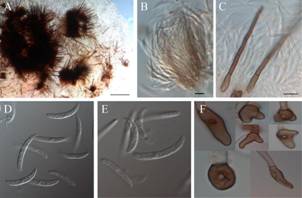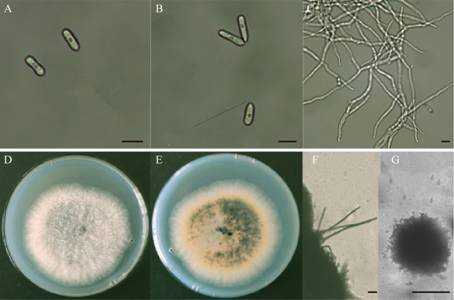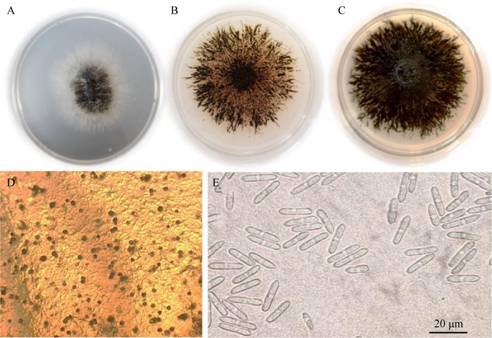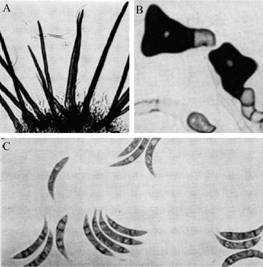扩展功能
文章信息
- 刘勇, 叶鹏盛, 曾华兰, 孙小芳, 何炼, 华丽霞, 蒋秋平, 何晓敏, 王明娟, 张敏
- LIU Yong, YE Pengsheng, ZENG Hualan, SUN Xiaofang, HE Lian, HUA Lixia, JIANG Qiuping, HE Xiaomin, WANG Mingjuan, ZHANG Min
- 豆类炭疽病病原物种类及其发生研究进展
- Research progress on pathogen species and occurrence of bean anthracnose
- 微生物学通报, 2021, 48(11): 4296-4305
- Microbiology China, 2021, 48(11): 4296-4305
- DOI: 10.13344/j.microbiol.china.210075
-
文章历史
- 收稿日期: 2021-01-22
- 接受日期: 2021-03-05
- 网络首发日期: 2021-05-12
大豆炭疽病是由炭疽菌属(Colletotrichum Corda)的一些真菌种引起的,主要有由平头炭疽菌等病原菌引起的8种症状类型,普遍发生于巴西、印度、美国南部及中国等。潮湿温暖条件下,炭疽病病害症状明显,病情严重度增加,导致美国南部地区种子产量损失16%−26%,泰国大豆产量损失30%−50%,印度大豆产量损失甚至可达100%,导致大豆减产16%−100%[1]。1996−2007年,大豆炭疽病造成阿根廷、巴西、中国和美国等8个大豆主要生产国产量损失达2 540万t,其中,产量损失最大的是中国,累计达1 660万t,其次是美国和印度,分别累计490万t和117万t[2]。2003−2005年大豆炭疽病成为美国15个南部州地区的十大重要大豆病害之一,是重要的世界性植物病害[3]。
根据前人的研究,能够引起大豆炭疽病的病原菌有:平头炭疽菌(Colletotrichum truncatum)[4],有性态未知;短孢炭疽菌(C. brevisporum)[5],有性态未知;毁灭炭疽菌(C. destructivum)[6-7],有性态(Glomerella glycines);胶孢炭疽菌(C. gloeosporioides)[8-10],有性态(G. cingulata);球炭疽菌(C. coccodes)[11],有性态未知;禾生炭疽菌(C. graminicola)[12],有性态(G. graminicola);剪炭疽菌(C. cliviae)[13];兰生炭疽菌(C. chlorophyti);黑线炭疽菌(C. dematium)等。大豆炭疽病是种传病害,可以侵染任何生育期的大豆,从种子至苗期再到收获期均可发病,感染种子使其变色且可能失去发芽能力[14],也可能在发芽期间死亡[15],苗期引起大豆死苗,成株期可危害茎秆、豆荚,造成植株过早落叶,导致大豆品质变劣[16]、产量下降[17-19]。
炭疽病的控制管理包括减少侵染源、施用杀菌剂、非寄主轮作和种植无致病性种子,病害循环和侵染过程包括越冬孢子的初次侵染、孢子萌发、分生孢子盘和孢子的产生,或病株组织菌丝体对植物的初次侵染、附着胞和侵染钉的发育、宿主组织的渗透和菌丝定殖[20]。因此,掌握引起大豆炭疽病的病原物种类及其特征,明确不同大豆产区引起大豆炭疽病的炭疽菌种类和分布是了解该病流行病学和指导综合防治策略的基础,对确保化学防治的成功和培育抗炭疽病大豆品种至关重要,为该病的科学防治提供理论依据。因此,本文对国内外大豆炭疽病的发生情况、炭疽菌种类及其特征进行了综述和讨论。
1 平头炭疽菌(Colletotrichum truncatum)1961年,由平头炭疽菌引起的大豆炭疽病首次报道发生于巴西的南里奥格兰德州并迅速流行于塞拉多草原等中西部大草原地区[21],随着2001年大豆锈病病原菌Phakopsora pachyrhizi传入巴西,大豆开始定期喷洒农药,炭疽病作为一种继发性病害持续存在,长期对大豆产量造成严重的损失,据报道,巴西北部大豆炭疽病发病率每增加1%便造成90 kg/hm2的产量损失[22]。在21世纪10年代,大豆炭疽病再次发生于巴西并造成重大损失[23]。目前的重大损失报告可能与病原菌固有的种间或其他变异性、气候和文化因素有关,也可能与主要商业大豆品种的基因构成变化有关。因此,学者们不断开展研究来阐明致病因子的性质和分布等[24]。
平头炭疽病由荷兰学者于2009年再次鉴定[25],并指出该病原菌是引起大豆炭疽病最主要的病原菌[26]。在PDA培养基上病原菌菌落颜色为浅灰色到深灰色,孢子堆为橙色或米橙色,培养7 d后菌落直径为3.0−9.0 cm。该病菌表现出3种类型的产孢方式,即由菌丝末端的分生细胞形成分生孢子、分生孢子盘形成分生孢子以及直接由可育的刚毛形成分生孢子。分生孢子单胞,镰状,透明,无隔膜(图 1),平均大小为(19.0−26.5) μm× (3.0−4.5) μm。

|
| 图 1 平头炭疽菌在显微镜下的形态学特征[24] Figure 1 Morphological characteristics of Colletotrichum truncatum under the microscope[24] 注:A:分生孢子盘;B:分生孢子盘和分生孢子;C:刚毛和分生孢子;D、E:分生孢子;F:附着胞。比例尺:A:100 μm;B–F:10 μm Note: A: Acervuli; B: Acervuli and conidia; C: Setae and conidia; D, E: Conidia; F: Appressoria. Scale bars: A: 100 μm; B–F: 10 μm |
|
|
2012年,美国科学家Yang等首次报道C. chlorophyti侵染大豆引起大豆炭疽病[27],随后2013年发现该菌可以侵染大豆种子[28]。2017年,我国河北检验检疫局京唐港办事处植物检疫实验室从进口的乌拉圭大豆的残留茎秆上分离并鉴定出该菌,为我国口岸首次截获[29]。2019年,Sun等[30]研究发现该菌侵染我国北苍术。
在PDA培养基上,该菌菌落圆形,边缘整齐,呈灰白色,气生菌丝毡状或绒状,紧贴培养基生长,培养3 d后菌丝开始变黑,7 d后黑色菌落满皿(图 2A、2B);厚垣孢子在培养3 d后开始产生,单生或串生于菌丝顶端或中间,黄褐色至黑褐色,多数球形,光滑,平均大小为7.5 μm×7.5 μm (图 2C);分生孢子单胞,无色,新月形或镰刀状,一端尖锐,另一端较钝,平均大小为19.4 μm×3.6 μm (图 2D),无附着胞产生[27]。
由胶孢炭疽菌引起的炭疽病是大豆豆芽最严重的病害之一[31]。2013年,胶孢炭疽菌首次被报道侵染马来西亚大豆,造成茎弯曲生长或环绕,顶梢枯死,随后叶片和茎上形成黑色病斑,豆荚被感染则出现红棕色病斑[9]。发病后期,病斑中出现大量的表皮尖刺,在相对湿度较高的时期出现黏液样的分生孢子团。
病原菌PDA培养物最初为白色,随后逐渐变为灰褐色、粉红色、红褐色(图 3A);在相对湿度较高的环境下培养一段时间后,产生针状花絮子囊孢子,大小为(13−26) μm×(4−8) μm;培养12 d后产生分生孢子,分生孢子直,圆柱形,透明,无隔,两端圆形,大小为(8−16) μm×(2−6) μm (图 3C)[9-10]。
大豆是阿根廷最主要的作物,由毁灭炭疽菌引起的大豆炭疽病同大豆黑斑病、大豆紫斑病和大豆叶斑病等病害在大豆生长后期发生严重,造成重大损失[32]。大豆炭疽病病原菌侵染豇豆,造成其叶和茎的蛋白质含量从34.91%降至20.40%、脂肪含量从5.42%降低至2.15%[33],种子中蛋白质损失28.95%、碳水化合物和脂肪损失22.55%[34]。
病原菌菌落正面由灰黑色变为黑色,而背面则由棕色变为深黑色;菌落生长呈放射状、圆形、脂肪状、颗粒状,气生菌丝稀疏,最初呈白色(图 4A);气生菌丝中散布有大量的针状突起,呈圆形或近圆形,深褐色,具刚毛(图 4B);分生孢子单细胞,透明,圆柱形,微弯,大小为(13.2–20.2) μm×(3.1–5.2) μm (图 4C)[35]。
1998年,由球炭疽菌引起的大豆炭疽病首次报道发生于美国[11],该病原菌宿主范围广,危害严重,以茄科作物为主,对作物种子的侵染率达14%。据调查,在苘麻-大豆种植田块,该菌侵染大豆,在植株上产生黑斑,坏死茎上形成菌核,造成大豆产量损失可达23%[36]。同时,该菌还被报道侵染辣椒[37]和豌豆[38],造成严重的产量损失。
病原菌在PDA培养基上的菌落最初为白色(图 5A),随着培养时间的延长逐渐变黑(图 5B、5C),16 d后产生大量黑色的小菌核(图 5D);分生孢子透明、无隔,圆柱状、有水滴状小斑点,两端圆形,孢子大小为(15.5−21.3) μm×(3.6−5.3) μm;附着胞椭圆形至卵球形,不规则分裂或弯曲[39]。
禾生炭疽菌较少被报道侵染大豆,其主要侵染玉米茎和叶,是引起玉米叶枯炭疽病和茎腐炭疽病的半营养真菌,造成玉米产量严重损失[40]。该菌侵染宿主引起炭疽病主要通过3个阶段,首先是入侵前宿主表面形成附着胞,然后通过营养生长定殖在宿主活细胞内,最后造成宿主细胞死亡出现发病症状[41-42],形成窄直形或椭圆形水浸状病斑,随着病情发展,病斑变为褐色至淡红褐色,最后变暗褐色至黑色,茎或叶表面上生有小黑点(分生孢子盘)。有时病斑合并成相当大的暗褐色至亮黑色、稍凹陷的斑块或条斑。研究发现,添加脲酶抑制剂乙酰羟肟酸可保护作物免受该病原菌侵染,从而降低炭疽病发病率[43]。
禾生炭疽菌分生孢子盘黑褐色,呈盘形或垫状,盘上密生棍棒状单细胞的分生孢子梗,无色至淡褐色,平滑,疏松排列成栅栏状(图 6A);梗顶生分生孢子,分生孢子有镰刀形和卵圆形2种[44]。镰刀形孢子有时略直,单胞无色,大小为(12−16) μm×(2.5−5.5) μm (图 6B);卵圆形孢子单胞无色,大小为(9.8−41.5) μm×(2.3−7.7) μm[45]。
2017年,由剪炭疽菌引起的大豆炭疽病首次报道发生于巴西[13],侵染大豆造成叶片和茎坏死,病斑平均大小为4.26 mm。该病原菌使大豆种子发芽率降低44%−55%,对大豆豆荚的致病性低于平头炭疽菌,在大豆茎上病斑显著小于由平头炭疽菌侵染形成的病斑[46]。在巴西,该菌还被报道侵染利马豆[47-48]和芒果[49]。同时,通过国内外分离菌的单倍型多样性分析和真菌寄主范围测定表明,剪炭疽菌可能为巴西高原地区特有。
剪炭疽菌在PDA培养基上形成灰色到深灰色的菌落(图 7A),生长迅速,即使在30−33 ℃的条件下其生长速度也显著快于平头炭疽菌,培养7 d后菌丝占满直径为9 cm的培养皿,并已经出现分生孢子;分生孢子单胞,透明,无隔,圆柱形,末端钝,平均大小为14.80 μm×4.44 μm (图 7C-7E);附着胞叶状或圆齿状,大小为(10−19) μm×(4−9) μm[46]。
2020年,中国江苏南通市首次报道短孢炭疽菌侵染大豆引起大豆炭疽病,发病率达65%,造成大豆产量较2019年降低28%−35%[5]。病原菌侵染大豆,造成茎和叶中出现不规则的棕色坏死病变,并明显萎蔫。该病原菌在中国桑树[50]、巴西利马豆[48]和拉丁美洲岛国甜椒[51]等作物报道过,其形态特征与Damm等[52]报道的短孢炭疽菌一致。
短孢炭疽菌在吐温-20培养基上,菌落直径较小,大约为9.21 mm;在PDA培养基上,菌落中心为灰白色,边缘白色,菌丝有隔膜。分生孢子圆柱形,单胞,平均长度为15 μm (图 8) [5]。

|
| 图 8 短孢炭疽菌形态特征[5] Figure 8 Morphological characteristics of Colletotrichum brevisporum[5] 注:A−C:分生孢子和菌丝形态,标尺为10 µm;D−E:在PDA培养基上菌落形态;F:刚毛,标尺为10 µm;G:无性繁殖体,标尺为100 µm Note: A−C: Morphology of C. brevisporum conidia and mycelia, bar: 10 µm; D−E: PDA culture; F: Setae, bar: 10 µm; G: Conidiomata, bar: 100 µm |
|
|
南美地区是世界上大豆种植最多的区域,世界上50%以上的大豆产于巴西和阿根廷,并不断向亚马逊南部延伸[54]。该区域面积约为5 360万hm2 [55-56],多为大豆净作或小麦-大豆连作栽培,易发生炭疽病。中国大豆常年种植面积为841.3万hm2。在我国,大豆炭疽病的发生南方重于北方,尤其是对南方鲜食大豆的生产造成严重影响,高发病田块病荚率可达50%以上[4],严重影响了鲜食大豆的产量和外观品质,进而造成重大的经济损失。近年来由于雨水增多,大豆炭疽病在我国南方鲜食大豆产区有明显加重的趋势;2020年3月该病造成江苏大豆产量损失28%−35%,是威胁大豆生产的重要病害[57]。
截至目前,国内外大豆炭疽病的主要病原是平头炭疽菌,其次是球炭疽菌、毁灭炭疽菌、禾生炭疽菌和胶孢炭疽菌[58]。在我国,大豆炭疽病的主要病原仍是平头炭疽菌[57, 59],其次是兰生炭疽菌[29]和胶孢炭疽菌[60]。目前有关大豆炭疽病的研究文献较多,但研究多集中在大豆炭疽病病害症状的识别与病原菌分离[18, 27, 59]、大豆品种抗病性鉴定[57]、大豆炭疽病防治[61]等方面,曾华兰等也在大豆炭疽病发生和抗病性鉴定方面进行了初步的探索,描述了大豆炭疽病的症状类型及发生情况,提出了相应的防治措施[62],研究证实由平头炭疽菌引起的大豆豆荚炭疽病是造成四川大豆减产、品质下降的主要病害。大豆炭疽菌分子类群和不同菌株的排他性或半排他性聚集与其地理来源存在着较强的相关性[63],由不同病菌引起的大豆炭疽病症状表现各不相同,发生规律也有所差异。目前,有关大豆炭疽病病原菌的形态学鉴定和分子生物学鉴定缺乏一定的研究,而研究表明,不同致病力的炭疽病分离菌株均可以造成严重的炭疽病,这可能与目前大豆栽培品种抗病能力较差有关[24],因此亟需筛选和培育抗病的大豆品种,而选育和利用抗性品种的前提是筛选得到优异的抗性资源[57]。目前我国尚无对炭疽病的免疫品种,因此,明确引起大豆炭疽病的主要病原物、生物学特征及发生发展规律,有利于在病害发生关键环节对其进行有效的防治,降低成本投入。研究证实选育推广抗病品种是防治大豆炭疽病最经济有效的方法,而品种的抗病性评价是筛选抗原和选育抗病品种不可缺少的手段[64]。因此,本团队制定了四川省地方标准《大豆品种抗炭疽病性鉴定技术规程》,连续多年对来自四川和重庆的鲜食大豆品种材料进行了大豆炭疽病的抗性评价,鉴定出中抗材料3份,中感材料22份,感病材料6份[64]。本结果可作为针对性地选用抗性材料、筛选抗病品种、育出抗病增产品种的依据。本文通过明确引起大豆炭疽病的主要病原物及其特征,综述了8种大豆炭疽菌特征特性,有利于鉴别大豆侵染复合物,为了解该病流行病学和指导综合防治策略奠定基础,对成功开展化学防治和培育抗炭疽病大豆品种具有重要意义。
| [1] |
Wrather JA, Anderson TR, Arsyad DM, Gai J, Ploper LD, Porta-Puglia A, Ram HH, Yorinori JT. Soybean disease loss estimates for the top 10 soybean producing countries in 1994[J]. Plant Disease, 1997, 81(1): 107-110. DOI:10.1094/PDIS.1997.81.1.107 |
| [2] |
Wrather A, Koenning S. Effects of diseases on soybean yields in the United States 1996 to 2007[J]. Plant Health Progress, 2009, 10(1): 24. DOI:10.1094/PHP-2009-0401-01-RS |
| [3] |
Yang HC, Haudenshield JS, Hartman GL. Colletotrichum incanum sp. nov., a curved-conidial species causing soybean anthracnose in USA[J]. Mycologia, 2014, 106(1): 32-42. DOI:10.3852/13-013 |
| [4] |
Wang T, Zhong RS, Gao ZM. Studies on the nutritive physiological characteristics of Colletotrichum truncatum[J]. Journal of Fungal Research, 2006, 4(3): 91-93. (in Chinese) 汪涛, 钟荣顺, 高智谋. 大豆炭疽病菌(Colletotrichum truncatum)的营养生理研究[J]. 菌物研究, 2006, 4(3): 91-93. DOI:10.3969/j.issn.1672-3538.2006.03.021 |
| [5] |
Shi XC, Wang SY, Duan XC, Gao X, Zhu XY, Laborda P. First report of Colletotrichum brevisporum causing soybean anthracnose in China[J]. Plant Disease, 2021, 105(3): 707. |
| [6] |
Baird RE, Mullinix BG, Peery AB, Lang ML. Diversity and longevity of the soybean debris mycobiota in a no-tillage system[J]. Plant Disease, 1997, 81(5): 530-534. DOI:10.1094/PDIS.1997.81.5.530 |
| [7] |
Ramos AM, Tadic LF, Cinto I, Carmona M, Gally M. Molecular characterization of Colletotrichum species causing soybean anthracnose in Argentina[J]. Mycotaxon, 2013, 123(1): 457-465. DOI:10.5248/123.457 |
| [8] |
Chen LS, Chu C, Liu CD, Chen RS, Tsay JG. PCR-based detection and differentiation of anthracnose pathogens, Colletotrichum gloeosporioides and C. truncatum, from vegetable soybean in Taiwan[J]. Journal of Phytopathology, 2006, 154(11/12): 654-662. |
| [9] |
Mahmodi F, Kadir JB, Wong MY, Nasehi A, Puteh A, Soleimani N. First report of anthracnose caused by Colletotrichum gloeosporioides on soybean (Glycine max) in Malaysia[J]. Plant Disease, 2013, 97(6): 841. |
| [10] |
Xiao JW, Liu YL, Ran JX, Yang ZC. Identification of Colletotrichum isolates from Brazil soybean[J]. Chinese Agricultural Science Bulletin, 2011, 27(5): 333-337. (in Chinese) 肖杰文, 刘月廉, 冉俊祥, 杨占臣. 巴西大豆中炭疽菌的分离鉴定研究[J]. 中国农学通报, 2011, 27(5): 333-337. |
| [11] |
Riccioni L, Conca G, Hartman GL. First report of Colletotrichum coccodes on soybean in the United States[J]. Plant Disease, 1998, 82(8): 959. |
| [12] |
Yang HC, Haudenshield JS, Hartman GL. Multiplex real-time PCR detection and differentiation of Colletotrichum species infecting soybean[J]. Plant Disease, 2015, 99(11): 1559-1568. DOI:10.1094/PDIS-11-14-1189-RE |
| [13] |
Barbieri MCG, Ciampi-Guillardi M, Moraes SRG, Bonaldo SM, Rogério F, Linhares RR, Massola NS Jr. First report of Colletotrichum cliviae causing anthracnose on soybean in Brazil[J]. Plant Disease, 2017, 101(9): 1677. |
| [14] |
Poti T, Mahawan K, Cheewangkoon R, Arunothayanan H, Akimitsu K, Nalumpang S. Detection and molecular characterization of carbendazim-resistant Colletotrichum truncatum isolates causing anthracnose of soybean in Thailand[J]. Journal of Phytopathology, 2020, 168(5): 267-278. DOI:10.1111/jph.12888 |
| [15] |
Gizlice Z, Carter TE Jr, Burton JW. Genetic diversity in North American soybean: I. multivariate analysis of founding stock and relation to coefficient of parentage[J]. Crop Science, 1993, 33(3): 614-620. DOI:10.2135/cropsci1993.0011183X003300030038x |
| [16] |
Allen TW, Bradley CA, Sisson AJ, Byamukama E, Chilvers MI, Coker CM, Collins AA, Damicone JP, Dorrance AE, Dufault NS, et al. Soybean yield loss estimates due to diseases in the United States and Ontario, Canada, from 2010 to 2014[J]. Plant Health Progress, 2017, 18(1): 19-27. DOI:10.1094/PHP-RS-16-0066 |
| [17] |
Backman PA, Williams JC, Crawford MA. Yield losses in soybeans from anthracnose caused by Colletotrichum truncatum[J]. Plant Disease, 1982, 66(11): 1032-1034. |
| [18] |
Manandhar JB, Hartman GL. Anthracnose[A]//Hartman GL, Sinclair JB, Rupe JC. Compendium of Soybean Diseases[J]. St. Paul, MN: APS Press, 1999, 13-14. |
| [19] |
Wrather JA, Koenning SR. Estimates of disease effects on soybean yields in the United States 2003 to 2005[J]. Journal of Nematology, 2006, 38(2): 173-180. |
| [20] |
Yang HC, Hartman GL. Methods and evaluation of soybean genotypes for resistance to Colletotrichum truncatum[J]. Plant Disease, 2015, 99(1): 143-148. DOI:10.1094/PDIS-03-14-0228-RE |
| [21] |
Araújo AG, Café-Filho AC, Cupertino FP. Antracnose da soja na região geoeconômica do Distrito Federal[J]. Fitopatologia Brasileira, 1988, 13: 130. |
| [22] |
Dias MD, Pinheiro VF, Café-Filho AC. Impact of anthracnose on the yield of soybean subjected to chemical control in the north region of Brazil[J]. Summa Phytopathologica, 2016, 42(1): 18-23. DOI:10.1590/0100-5405/2114 |
| [23] |
Rogério F, Gladieux P, Massola NS, Ciampi-Guillardi M. Multiple introductions without admixture of Colletotrichum truncatum associated with soybean anthracnose in Brazil[J]. Phytopathology, 2019, 109(4): 681-689. DOI:10.1094/PHYTO-08-18-0321-R |
| [24] |
Rogério F, Ciampi-Guillardi M, Barbieri MCG, Bragança CAD, Seixas CDS, Almeida AMR, Massola NS. Phylogeny and variability of Colletotrichum truncatum associated with soybean anthracnose in Brazil[J]. Journal of Applied Microbiology, 2017, 122(2): 402-415. DOI:10.1111/jam.13346 |
| [25] |
Damm U, Woudenberg JH, Cannon PF, Crous P. Colletotrichum species with curved conidia from herbaceous hosts[J]. Fungal Diversity, 2009, 39: 45-87. |
| [26] |
Hyde KD, Cai L, McKenzie EHC, Yang YL, Zhang JZ, Prihastuti H. Colletotrichum: a catalogue of confusion[J]. Fungal Diversity, 2009, 39: 1-17. |
| [27] |
Yang HC, Haudenshield JS, Hartman GL. First report of Colletotrichum chlorophyti causing soybean anthracnose[J]. Plant Disease, 2012, 96(11): 1699. |
| [28] |
Yang HC, Stewart JM, Hartman GL. First report of Colletotrichum chlorophyti infecting soybean seed in Arkansas, United States[J]. Plant Disease, 2013, 97(11): 1510. |
| [29] |
Li HY, Jin S, Zhang XQ, Fan GH, Zhang JX, Xu YX. Identification of Colletotrichum chlorophyti causing soybean anthracnose[J]. Plant Protection, 2017, 43(2): 163-166. (in Chinese) 李海云, 靳帅, 张学勤, 范光辉, 张建新, 许艳霞. 大豆炭疽病菌Colletotrichum chlorophyti的鉴定[J]. 植物保护, 2017, 43(2): 163-166. DOI:10.3969/j.issn.0529-1542.2017.02.028 |
| [30] |
Sun WM, Wen XL, Qi HX, Feng LN, Cao J, Han ZL, Yang WJ, Zhang MY, Han BJ, Meng TY. First report of anthracnose of Atractylodes chinensis caused by Colletotrichum chlorophyti in China[J]. Plant Disease, 2019, 103(4): 764. |
| [31] |
Lee JH, Jeong SW, Cho YA, Park S, Kim YH, Bae DW, Chung JI, Kwak YS, Jeong MJ, Park SC, et al. Determination of the variations in levels of phenolic compounds in soybean (Glycine max Merr.) sprouts infected by anthracnose (Colletotrichum gloeosporioides)[J]. Journal of the Science of Food and Agriculture, 2013, 93(12): 3081-3086. DOI:10.1002/jsfa.6142 |
| [32] |
Carmona M, Sautua F, Perelman S, Reis EM, Gally M. Relationship between late soybean diseases complex and rain in determining grain yield responses to fungicide applications[J]. Journal of Phytopathology, 2011, 159(10): 687-693. DOI:10.1111/j.1439-0434.2011.01828.x |
| [33] |
Amadioha AC, Nwazuo ED. Alterations of biochemical composition of leaf and stem of cowpea (Vigna unguiculata (L.) Walp.) by Colletotrichum destructivum O'Gara in Nigeria[J]. Journal of Experimental Agriculture International, 2019, 33(2): 1-7. |
| [34] |
Amadioha AC, Nwazuo ED. Biochemical composition of seed and husk of cowpea (Vigna unguiculata (L.) Walp.) infected by Colletotrichum destructivum O'Gara in storage[J]. Annual Research & Review in Biology, 2019, 331(1): 1-7. |
| [35] |
Sun HY, Tian JM, Steinkellner S, Liang Y. Identification and characterization of Colletotrichum destructivum causing anthracnose on sunflower[J]. Archives of Microbiology, 2020, 202(6): 1459-1467. DOI:10.1007/s00203-020-01861-8 |
| [36] |
Ditommaso A, Watson AK, Hallett SG. Infection by the fungal pathogen Colletotrichum coccodes affects velvetleaf (Abutilon theophrasti)-soybean competition in the field[J]. Weed Science, 1996, 44(4): 924-933. DOI:10.1017/S0043174500094935 |
| [37] |
Tyvaert L, Everaert E, Lippens L, Cuijpers WJM, França SC, Höfte M. Interaction of Colletotrichum coccodes and Verticillium dahliae in pepper plants[J]. European Journal of Plant Pathology, 2019, 155(4): 1303-1317. DOI:10.1007/s10658-019-01857-1 |
| [38] |
Bellé C, Ramos RF, Moccellin R, Farias CRJ. Detection of Colletotrichum coccodes causing leaf anthracnose on Pisum sativum in southern Brazil[J]. Journal of Plant Pathology, 2020, 102(1): 255. DOI:10.1007/s42161-019-00392-6 |
| [39] |
Pérez-Mora JL, Cota-Rodríguez DA, Rodríguez-Palafox EE, García-León E, Beltrán-Peña H, Lima NB, Tovar-Pedraza JM. First confirmed report of Colletotrichum coccodes causing black dot on potato in Mexico[J]. Journal of Plant Diseases and Protection, 2020, 127(2): 269-273. DOI:10.1007/s41348-019-00291-z |
| [40] |
Gorman Z, Christensen SA, Yan YX, He YM, Borrego E, Kolomiets MV. Green leaf volatiles and jasmonic acid enhance susceptibility to anthracnose diseases caused by Colletotrichum graminicola in maize[J]. Molecular Plant Pathology, 2020, 21(5): 702-715. DOI:10.1111/mpp.12924 |
| [41] |
Gong AD, Jing ZY, Zhang K, Tan QQ, Wang GL, Wen DL. Bioinformatic analysis and functional characterization of the CFEM proteins in maize anthracnose fungus Colletotrichum graminicola[J]. Journal of Integrative Agriculture, 2020, 19(2): 541-550. DOI:10.1016/S2095-3119(19)62675-4 |
| [42] |
Torres MF, Ghaffari N, Buiate EAS, Moore N, Schwartz S, Johnson CD, Vaillancourt LJ. A Colletotrichum graminicola mutant deficient in the establishment of biotrophy reveals early transcriptional events in the maize anthracnose disease interaction[J]. BMC Genomics, 2016, 17(1): 1-24. |
| [43] |
Benatto Perino EH, Glienke C, De Oliveira Silva A, Deising HB. Molecular characterization of the purine degradation pathway genes ALA1 and URE1 of the maize anthracnose fungus Colletotrichum graminicola identified urease as a novel target for plant disease control[J]. Phytopathology, 2020, 110(9): 1530-1540. DOI:10.1094/PHYTO-04-20-0114-R |
| [44] |
Nordzieke DE, Sanken A, Antelo L, Raschke A, Deising HB, Pöggeler S. Specialized infection strategies of falcate and oval conidia of Colletotrichum graminicola[J]. Fungal Genetics and Biology, 2019, 133: 103276. DOI:10.1016/j.fgb.2019.103276 |
| [45] |
Politis DJ. The identity and perfect state of Colletotrichum graminicola[J]. Mycologia, 1975, 67(1): 56-62. DOI:10.2307/3758227 |
| [46] |
Dias MD, Fonseca MEN, Dias-Neto JJ, Santos MDM, Pandolfo GM, Boiteux LS, Café-Filho AC. Biology, pathogenicity, and haplotype analyses of Colletotrichum cliviae: a novel soybean anthracnose agent in warm tropical areas[J]. Tropical Plant Pathology, 2018, 43(5): 439-451. DOI:10.1007/s40858-018-0249-6 |
| [47] |
Sousa ES, Silva JRA, Assunção IP, Melo MP, Feijó FM, Silva Matos K, Andrade Lima GS, Beserra JEA. Colletotrichum species causing anthracnose on lima bean in Brazil[J]. Tropical Plant Pathology, 2018, 43(1): 78-84. DOI:10.1007/s40858-017-0182-0 |
| [48] |
Cavalcante GRS, Barguil BM, Vieira WAS, Lima WG, Michereff SJ, Doyle VP, Câmara MPS. Diversity, prevalence, and virulence of Colletotrichum species associated with lima bean in Brazil[J]. Plant Disease, 2019, 103(8): 1961-1966. DOI:10.1094/PDIS-11-18-2002-RE |
| [49] |
Vieira WAS, Michereff SJ, Morais MA, Hyde KD, Câmara MPS. Endophytic species of Colletotrichum associated with mango in northeastern Brazil[J]. Fungal Diversity, 2014, 67(1): 181-202. DOI:10.1007/s13225-014-0293-6 |
| [50] |
Xue LH, Zhang L, Yang XX, Huang XQ, Wu WX, Zhou XQ, White JF, Liu Y, Li CJ. Characterization, phylogenetic analyses, and pathogenicity of Colletotrichum species on Morus alba in Sichuan province, China[J]. Plant Disease, 2019, 103(10): 2624-2633. DOI:10.1094/PDIS-06-18-0938-RE |
| [51] |
Villafana RT, Ramdass AC, Rampersad SN. Colletotrichum brevisporum is associated with anthracnose of red bell pepper fruit in Trinidad[J]. New Disease Reports, 2019, 39(1): 11. DOI:10.5197/j.2044-0588.2019.039.011 |
| [52] |
Damm U, Sato T, Alizadeh A, Groenewald JZ, Crous PW. The Colletotrichum dracaenophilum, C. magnum and C. orchidearum species complexes[J]. Studies in Mycology, 2019, 92: 1-46. DOI:10.1016/j.simyco.2018.04.001 |
| [53] |
Villafana RT, Rampersad SN. Diversity, structure, and synteny of the cutinase gene of Colletotrichum species[J]. Ecology and Evolution, 2020, 10(3): 1425-1443. DOI:10.1002/ece3.5998 |
| [54] |
United States Department of Agriculture. World agricultural supply and demand estimates 2019[EB/OL]. Washington, DC, USA: USDA, 2019. [2019-09-09]. https://www.usda.gov/sites/default/files/documents/March_2019_WASDE_Lockup_Briefing.pdf
|
| [55] |
CONAB. Companhia Nacional de Abastecimento—Boletim Grãos Junho 2019[EB/OL]. Brasília, Brazil: CONAB. [2019-09-09]. https://www.conab.gov.br/info-agro/safras/graos/boletim-da-safra-de-graos
|
| [56] |
Ministerio de Agricultura, Argentina. Estimaciones agrícolas al 05 de Septiembre 2019[EB/OL]. Buenos Aires, Argentina: Ministerio de Agricultura, Ganaderia y Pesca. [2019-09-09]. https://www.agroindustria.gob.ar/sitio/areas/estimaciones/
|
| [57] |
Feng LL, Zhu LM, Xie H, Yang QH, Guo B, Yuan FJ. Identification of the pathogen of vegetable soybean anthracnose in Zhejiang Province and evaluation of soybean cultivars for resistance to Colletotrichum truncatum[J/OL]. Acta Phytopathologica Sinica, 1-15. [2021-02-20]. https://doi.org/10.13926/j.cnki.apps.000730 (in Chinese) 冯乐乐, 竹龙鸣, 谢华, 杨清华, 郭蓓, 袁凤杰. 浙江省鲜食大豆炭疽病病原分离及抗性鉴定[J/OL]. 植物病理学报, 1-15. [2021-02-20]. https://doi.org/10.13926/j.cnki.apps.000730 |
| [58] |
Dias MD, Dias-Neto JJ, Santos MDM, Formento AN, Bizerra LVAS, Fonseca MEN, Boiteux LS, Café-Filho AC. Current status of soybean anthracnose associated with Colletotrichum truncatum in Brazil and Argentina[J]. Plants, 2019, 8(11): 459. DOI:10.3390/plants8110459 |
| [59] |
Chen WJ. Identification and control of soybean pod anthracnose[D]. Hangzhou: Master's Thesis of Zhejiang University, 2007 (in Chinese) 陈吴健. 大豆豆荚炭疽病的病原鉴定及其防治[D]. 杭州: 浙江大学硕士学位论文, 2007 |
| [60] |
Sun J, Xu B, Zhou CB. Diagnoses of anthraces in legume plants in Xichang district[J]. Journal of Xichang University: Natural Science Edition, 2004, 18(4): 83-84. (in Chinese) 孙劲, 徐彪, 周长彬. 西昌地区豆科植物炭疽病的鉴定[J]. 西昌学院学报(自然科学版), 2004, 18(4): 83-84. |
| [61] |
Sun ZF. Study on disease factors of soybean pod anthracnose and its control[D]. Hangzhou: Master's Thesis of Zhejiang University, 2008 (in Chinese) 孙志峰. 大豆豆荚炭疽病的发病因子及其防治研究[D]. 杭州: 浙江大学硕士学位论文, 2008 |
| [62] |
Zeng HL, He L, Ye PS, Jiang QP, Hua LX, Wang MJ, Zhang M, He XM. The main diseases of soybean in Sichuan and their control measures[A]//Proceedings of the 2019 Annual Meeting of the Chinese Society for Plant Protection[C]. Guiyang: Plant Protection Society of China, 2019: 70 (in Chinese) 曾华兰, 何炼, 叶鹏盛, 蒋秋平, 华丽霞, 王明娟, 张敏, 何晓敏. 四川大豆主要病害及其防治措施[A]//中国植物保护学会2019年学术年会论文集[C]. 贵阳: 中国植物保护学会, 2019: 70 |
| [63] |
Liu Y, Zeng HL, Hua LX, He L, Ye PS. Symptoms and occurrence of soybean Anthracnose[A]//Chen WQ. Plant Health and Pest Control[C]. Plant Protection Society of China, 2020: 1 (in Chinese) 刘勇, 曾华兰, 华丽霞, 何炼, 叶鹏盛. 大豆炭疽病菌的症状类型及其发生[A]//陈万全. 植物健康与病虫害防控[C]. 中国植物保护学会, 2020: 1 |
| [64] |
Zeng HL, He L, Jiang QP, Hua LX, Li Y, He XM, Wang MJ. Resistance evaluation to soybean anthracnose of fresh soybean varieties[A]//Chen WQ. Plant Health and Pest Control[C]. Plant Protection Society of China, 2020: 1 (in Chinese) 曾华兰, 何炼, 蒋秋平, 华丽霞, 刘勇, 何晓敏, 王明娟. 鲜食大豆品种对大豆炭疽病的抗性评价[A]//陈万全. 植物健康与病虫害防控[C]. 中国植物保护学会, 2020: 1 |
 2021, Vol. 48
2021, Vol. 48










